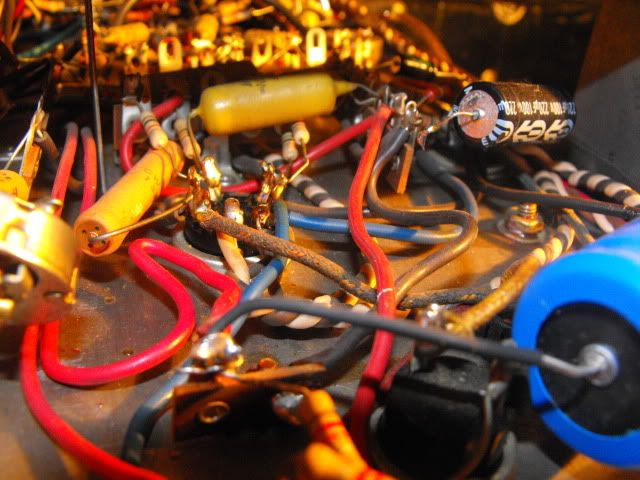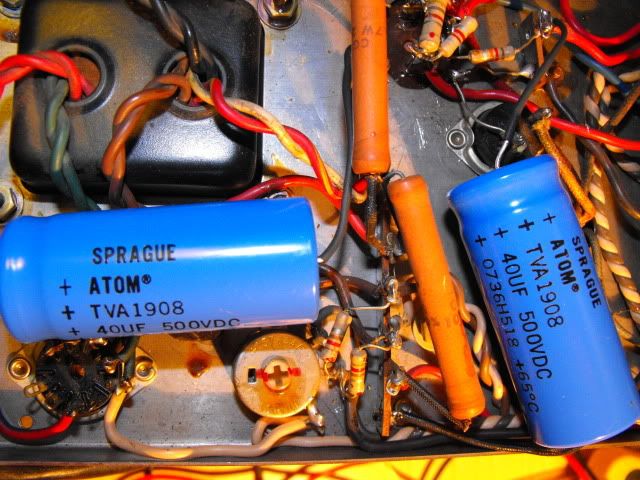Hi Zac: "Never look a gift of a working amplifier in the chassis" St Leo of Fender ... Next time you tug the chassis out, take a couple of pics ... yes, I know that cross bar is in the way.zulu said:Okay there is a resistor that comes off pin 7 of the other power tube (this would be common with the + of that 22uF cap) ... but it doesn't go to ground, it goes to a terminal where it splits up about 4 different ways, none to ground ...
A few words about bias and why a resistor in parallel with that cap is of interest; when the amp is on but no signal present, there's current running from the plate (+) to the cathode (-) [and electrons flowing in the opposite direction ... more on them in a minute]. In a sense, it mimics a car at idle; set too low, the engine is sluggish responding to acceleration and if too high, not enough remaining rpm range to do much; in terms of tube bias these extremes are cold and hot respectively. For current to flow, the voltage on the cathode has to be higher than the voltage on the grid ... the pin where the musical signal goes in ... the amplified signal goes out via the plate.
There are two ways to ensure that the voltage on the cathode is higher than the voltage on the grid; 'force' a voltage to appear there by putting a resistor between the cathode and ground ... 'cathode bias' ... how it's done for most older and low-power student amps. For reasons of gain and frequency response, that resistor is commonly bypassed with a 25uf-50uf/25V electrolytic cap ... like the one showing in your amp that I asked you about. The other way to create a condition where the grid is more negative than the cathode / cathode more positive than the grid is by injecting a negative voltage on the grid and have no resistor between the cathode and ground ... schematically, this is how the T1 RVT is 'biased'.
Since there's no resistor on the cathode and it's connected directly to chassis ground, its voltage as a practical matter is 0 but the grid is negative with respect to the cathode because you and I just injected a negative voltage there .... 'fixed bias'. When the AC signal arrives at the grid, it 'irritates' the plate and the current flowing at idle increases proportional to the strength of the inbound signal but the voltage relationship between grid and cathode (grid lower than cathode) has to stay the same ... else the current won't flow at all. So; the term bias is a noun ... the voltage relationship or differential between the cathode and grid ... and a verb ... to measure/test/set that voltage relationship.
Belts and suspenders: occasionally you'll see amps that have both a negative voltage applied to the grid and a cathode resistor. Since there is an electrolytic capacitor of the type and rating commonly associated with cathode-bias schemes in your amp, weez looking to see if there's a resistor present too ... doesn't have to be but, despite the presence of a bias tap (two brown wires ... the source of a 'fixed bias' voltage) on the transformer, there could be one there nevertheless.
A word about our friends the electrons; the cathode is heated by the filaments; just like the heating elements on an electric stove top ... the filament sits behind the cathode and warms it so that it freely and happily gives up electrons that flow from chassis ground through the tube towards the plate in the opposite direction as the current; in the eight grade, we learned that DC current flows from postive / the anode / the + terminal to ground. While that current is flowing from the plate / anode to the cathode, there's a stream of electrons heading towards the plate ... the source of DC current and where the signal exits the tube.
Okay ... okay ... you're saying 'get to the damn point Juan willya' ... The musical signal is AC ... analog ... a sinusoidal waveform ... as the positive half of the waveform appears at the grid ... wait for it ... the electrons rushing from the cathode to the plate print an exact copy of the waveform on the plate/anode ... except that it's larger in amplitude. In a twin output tube design, the negative half of the waveform goes to the other output tube and it's copied by the stream of electrons onto the plate except larger in amplitude / volume whatever word you want to use. The current/electron flow principle applies to the preamp tubes as well.
I think your T1 is an earlier version; better grade 1w resistors in the preamp and the reverb section is hard-wired to the chassis and not sitting up on its own circuit board like most T1s and version 1 Thunderbirds and my interest in the presence/absence of a cathode resistor is about variations / evolution in the model's design. Occasionally, people have posted amps where the fixed bias scheme has been cowboyed into cathode bias ... rare but it happens.
J




